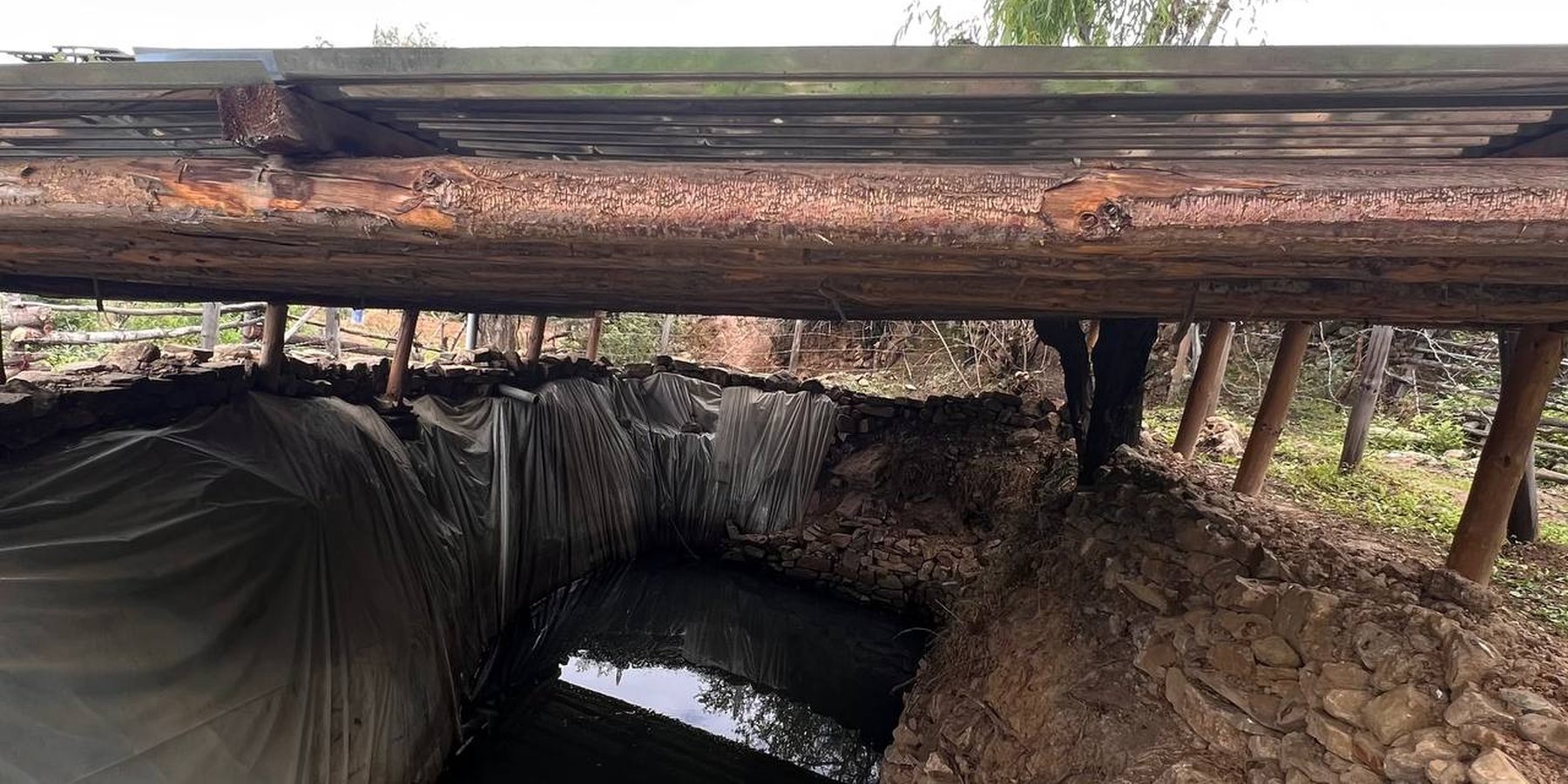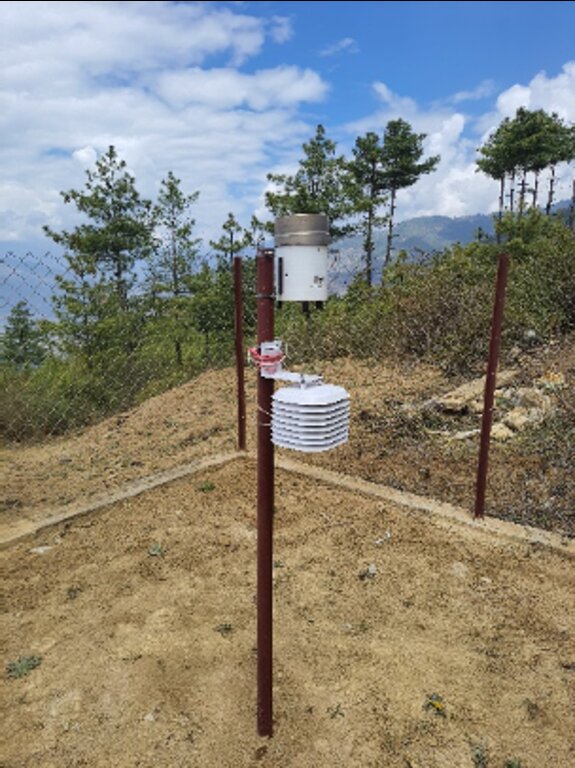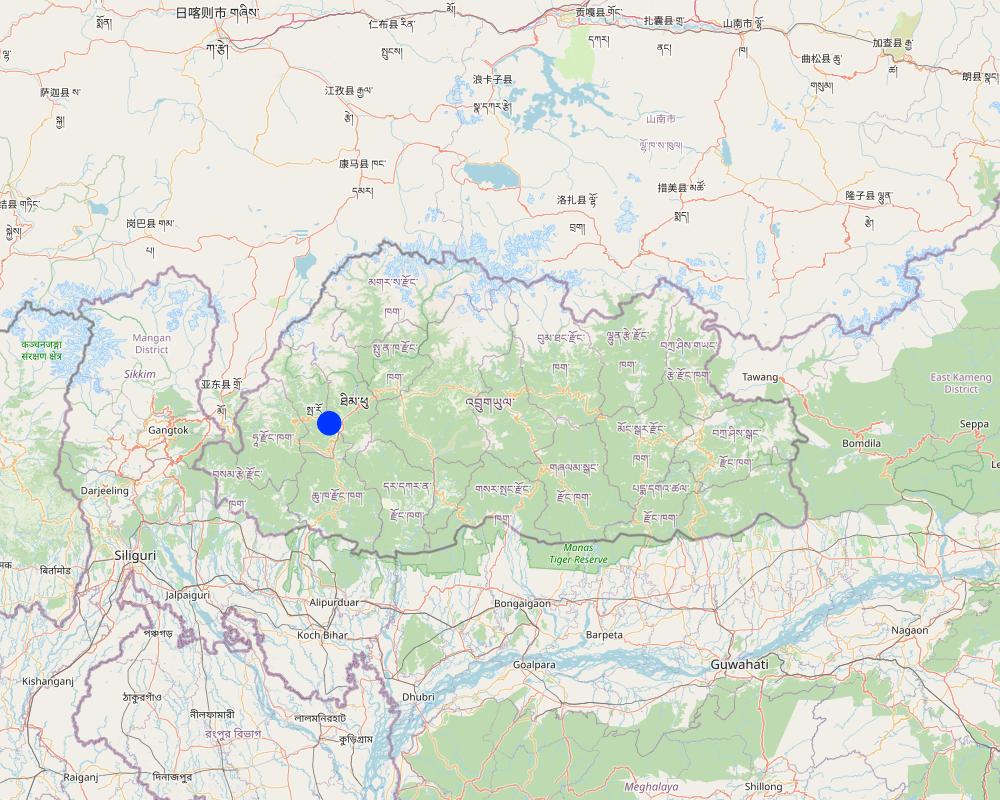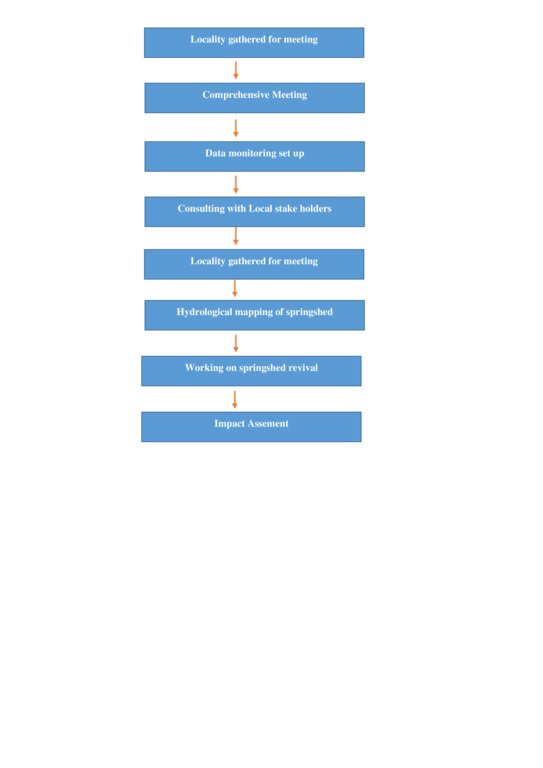Nature-based Solutions for Springshed Revival [Bhoutan]
- Création :
- Mise à jour :
- Compilateur : Karma Wangdi
- Rédacteur : Haka Drukpa
- Examinateurs : Rima Mekdaschi Studer, William Critchley
Rangzhin Thablam Thok Chhuka Sakhong Nyamsuung (རང་བཞིན་ཐབས་ལམ་ཐོག་ཆུ་རྐ་ས་ཁོངས་ཉམས་སྲུང་།)
approaches_6850 - Bhoutan
Voir les sections
Développer tout Réduire tout1. Informations générales
1.2 Coordonnées des personnes-ressources et des institutions impliquées dans l'évaluation et la documentation de l'Approche
Personne(s) ressource(s) clé(s)
exploitant des terres:
Dorji Gem
n/a
Lholing, Shaba Gewog (Block), Paro Dzongkhag (District)
Bhoutan
exploitant des terres:
Chencho Chencho
n/a
Lholing, Shaba Gewog (Block), Paro Dzongkhag (District)
Bhoutan
exploitant des terres:
Dorji Chencho
n/a
Lholing, Shaba Gewog (Block), Paro Dzongkhag (District)
Bhoutan
exploitant des terres:
Nidup Wangmo
n/a
Lholing, Shaba Gewog (Block), Paro Dzongkhag (District)
Bhoutan
Nom du projet qui a facilité la documentation/ l'évaluation de l'Approche (si pertinent)
Strengthening national-level institutional and professional capacities of country Parties towards enhanced UNCCD monitoring and reporting – GEF 7 EA Umbrella II (GEF 7 UNCCD Enabling Activities_Umbrella II)Nom du ou des institutions qui ont facilité la documentation/ l'évaluation de l'Approche (si pertinent)
National Soil Services Center, Department of Agric (National Soil Services Center, Department of Agric) - Bhoutan1.3 Conditions relatives à l'utilisation par WOCAT des données documentées
Quand les données ont-elles été compilées (sur le terrain)?
12/07/2023
Le compilateur et la(les) personne(s) ressource(s) acceptent les conditions relatives à l'utilisation par WOCAT des données documentées:
Oui
2. Description de l'Approche de GDT
2.1 Courte description de l'Approche
Springshed revival can be achieved through Nature-based Solutions (NbS) with a hydrogeological approach, complemented by socio-ecological inputs, and engineering surveys.
2.2 Description détaillée de l'Approche
Description détaillée de l'Approche:
Springs are natural occurrences where fresh water emerges from the ground through openings known as spring vents. They are outlets from aquifers, water-bearing layers underground, to the surface. The water in springs originates from rainfall during specific seasons, which falls on the springshed, infiltrates the ground and is collected as groundwater. When the groundwater is pressurized and rises, it creates springs, which then contribute to the flow of water into rivers or other water bodies. In mountainous regions like Bhutan, springs serve as the primary water source for rural households (ICIMOD, 2021).
Spring revival through “nature-based solutions” (NbS) in springsheds refers to a comprehensive effort aimed at reviving and restoring the functionality of springs. The primary objectives of spring revival initiatives include ensuring sustainable water supply, mitigating the threat of springs drying, conserving biodiversity, and improving the livelihoods of communities dependent on spring water. To achieve these goals, diverse methods are employed, involving various stakeholders. While spring revival offers numerous advantages, it also presents certain disadvantages that should be considered (Konek & Samanta, 2022).
The methods used under NbS to revive springs are multifaceted and typically involve a combination of hydrogeological, ecological, hydrological, and community-based approaches. Hydrogeology can lead to a better understanding of aquifers and the nature of springs and springsheds, thus providing ways for better management. Ecological methods focus on restoring the natural catchment area (the springshed itself) and improving vegetation cover to enhance water infiltration and recharge. Measures such as reforestation, contour trenching, and check dams are implemented to reduce erosion, promote groundwater recharge, and maintain spring flow. Hydrological interventions include the construction of recharge structures, groundwater recharge pits, and percolation tanks to replenish the aquifer and ensure sustained spring flow. Community-based approaches encompass raising awareness, capacity building, and participation in springshed conservation and management activities. These efforts often include the establishment of user groups, water committees, and the adoption of sustainable water use practices (Shrestha et al., 2017).
Stakeholders play vital roles in spring revival initiatives. Local communities living in Lholing areas are key stakeholders as they are directly affected by water availability and are actively involved in the preservation and management of springs. Government agencies such as the Department of Water, Department of Forests and Park Services and Gewog Administration provide technical expertise, funding, and policy support. Academic institutions and research organizations contribute scientific knowledge, monitoring, and evaluation, while international agencies and donor organizations may provide financial assistance and expertise.
According to Tamba et al. (2012) the advantages of spring revival are significant and far-reaching. By restoring spring flow, communities get access to a reliable and sustainable water source, which is crucial for their domestic, agricultural, and livestock needs. Spring revival through NbS also contributes to biodiversity conservation, as the presence of flowing water supports diverse aquatic and terrestrial ecosystems, including endemic species. Moreover, the revival of springs enhances groundwater recharge, which can benefit other water sources in the area. The community involvement and capacity-building aspects of NbS initiatives foster social cohesion, empowerment, and the development of local governance structures. Revived springs have the potential to enhance community resilience to climate change by providing water during periods of drought or erratic rainfall.
However, NbS also come with certain challenges and disadvantages. Adequate financial resources and long-term funding commitments are often required, which can pose a challenge in resource-constrained settings. Technical expertise and knowledge gaps may hinder the effectiveness of revival methods, emphasizing the need for capacity building and technical support. The involvement of multiple stakeholders can lead to coordination issues and conflicts of interest. Furthermore, the success of spring revival initiatives relies heavily on community participation. Thus, lack of community engagement or ownership can hinder sustainability. Environmental and social impacts need to be carefully considered, as inappropriate interventions or changes in hydrological patterns can have unintended consequences on ecosystems and communities (Khadka et al., 2019).
2.3 Photos de l'approche
2.4 Vidéos de l'Approche
Date:
12/07/2023
2.5 Pays/ région/ lieux où l'Approche a été appliquée
Pays:
Bhoutan
Région/ Etat/ Province:
Shaba, Paro
Autres spécifications du lieu :
Lholing Chiwog, Shaba Geog, Paro Dzongkhag
Map
×2.6 Dates de début et de fin de l'Approche
Indiquez l'année de démarrage:
2018
Si l'année précise est inconnue, indiquez approximativement quand l'Approche a démarré:
il y a moins de 10 ans (récemment)
2.7 Type d'Approche
- fondé sur un projet/ programme
2.8 Principaux objectifs de l'Approche
Nature-based solution to reviving springs as a source of water for:
1. Drinking
2. For animal use
3. Agriculture
2.9 Conditions favorisant ou entravant la mise en œuvre de la(des) Technologie(s) appliquée(s) sous l'Approche
normes et valeurs sociales/ culturelles/ religieuses
- favorise
Water became the source of whole existence.
disponibilité/ accès aux ressources et services financiers
- favorise
This type of project can be brought into action with the help of continued implementation of activities and grants
cadre institutionnel
- favorise
More stakeholders
collaboration/ coordination des acteurs
- favorise
cadre juridique (régime foncier, droits d'utilisation des terres et de l'eau)
- favorise
Water Act of Bhutan 2010
cadre politique
- favorise
Drinking water has been a priority over other usage as per our Act and policies.
gouvernance foncière (prise de décisions, mise en œuvre et application des décisions)
- favorise
The Department of Water and Department of Forests and Park Services have been promoting conservation and management of water resources.
connaissances sur la GDT, accès aux supports techniques
- entrave
Our farmers usually lacks the knowledge on SLM principle left without assisting in this type of field.
marchés (pour acheter les intrants, vendre les produits) et prix
- favorise
The communities have access to local markets to sell their agricultural products.
charge de travail, disponibilité de la main-d'œuvre
- entrave
Required huge labour contributions. Labour shortage is a problem
autre
- favorise
3. Participation et rôles des parties prenantes impliquées dans l'Approche
3.1 Parties prenantes impliquées dans l'Approche et rôles
- exploitants locaux des terres / communautés locales
A total of 8 stakeholders were involved, only two of them are directly assisting in spring revival
Helped as a labor who have contributed in making trenches and fencing around the shed.
- Spécialistes de la GDT/ conseillers agricoles
8 Foresters from the Divisional Forest Office, Paro were involved
Planning, coordinating and providing technical assistance for the spring revival
- gouvernement local
Gup (Local Chief) and Tshogpa of Shaba Gewog Administration.
Administrative support
- gouvernement national (planificateurs, décideurs)
Department of Forests and Park Services
Provide technical support
- organisation internationale
Green Climate Fund, ICIMOD
Provide funding support and tecnnical expertise
3.2 Participation des exploitants locaux des terres/ communautés locales aux différentes phases de l'Approche
| Participation des exploitants locaux des terres/ communautés locales | Spécifiez qui était impliqué et décrivez les activités | |
|---|---|---|
| initiation/ motivation | interactive | A person from each household was involved in the initial planning and meeting with the specialists to agree to. |
| planification | passive | The plannings were mostly done by specialists from the forest department. |
| mise en œuvre | soutien extérieur | Land users/local community were engaged as paid labours. |
| suivi/ évaluation | interactive | Twice a year monitoring is done by the specialists and other minor monitoring is dine by the community around the springsheds. |
| aucun | No research was carried out. |
3.3 Diagramme/ organigramme (si disponible)
Description:
1. Comprehensive mapping of springs and springsheds.
2. Setting up of a data monitoring system.
3. Understanding socio-economic and governance systems of springs.
4. Hydrogeological mapping.
5. Creating a conceptual hydrogeological layout of the springshed.
6. Classification of spring type, identifying mountain aquifer and demarcating recharge area.
7. Developing springshed management and governance protocols and
8. Impact assessment.
Auteur:
Singye Dorji & Tshering Gyeltshen
3.4 Prises de décision pour la sélection de la Technologie/ des Technologies
Indiquez qui a décidé de la sélection de la Technologie/ des Technologies à mettre en œuvre:
- principalement les spécialistes de la GDT, après consultation des exploitants des terres
4. Soutien technique, renforcement des capacités et gestion des connaissances
4.1 Renforcement des capacités/ formation
Une formation a-t-elle été dispensée aux exploitants des terres/ autres parties prenantes?
Non
4.2 Service de conseils
Les exploitants des terres ont-ils accès à un service de conseils?
Oui
Spécifiez si le service de conseils est fourni:
- dans les champs des exploitants?
4.3 Renforcement des institutions (développement organisationnel)
Des institutions ont elles été mises en place ou renforcées par le biais de l'Approche?
- oui, un peu
Spécifiez à quel(s) niveau(x), ces institutions ont été renforcées ou mises en place:
- local
4.4 Suivi et évaluation
Le suivi et l'évaluation font ils partie de l'Approche? :
Oui
Commentaires:
Physical on site monitoring and evaluating the springshed
Si oui, ce document est-il destiné à être utilisé pour le suivi et l'évaluation?
Non
4.5 Recherche
La recherche a-t-elle fait partie intégrante de l’Approche?
Non
5. Financement et soutien matériel externe
5.1 Budget annuel de la composante GDT de l'Approche
Si le budget annuel précis n'est pas connu, indiquez une fourchette:
- < 2 000
Commentez (par ex. principales sources de financement/ principaux bailleurs de fonds):
Royal Government of Bhutan funding was released under Ministry of Energy and Natural Resources (erstwhile Ministry of Agriculture and Forests).
5.2 Soutiens financiers/ matériels fournis aux exploitants des terres
Les exploitants des terres ont-ils reçu un soutien financier/ matériel pour la mise en œuvre de la Technologie/ des Technologies?
Oui
Si oui, spécifiez le(s) type(s) de soutien, les conditions et les fournisseurs:
The government fully funded the initiative of springshed revival where they even paid N. 700 to the labour helpers that from the community engaged.
5.3 Subventions pour des intrants spécifiques (incluant la main d'œuvre)
- main d'œuvre
| Dans quelle mesure | Spécifiez les subventions |
|---|---|
| entièrement financé | Paid for the local labourers and also 4 technicals staffs from Department of Forest and Park Services. |
- équipement
| Spécifiez les intrants subventionnés | Dans quelle mesure | Spécifiez les subventions |
|---|---|---|
| machines | entièrement financé | One Excavator untill the completion of the project. |
| outils | entièrement financé | Basic tools such as spades, crowbars and shovel. |
| entièrement financé | Lunch and refreshments for all the labourers. | |
- matériaux de construction
| Spécifiez les intrants subventionnés | Dans quelle mesure | Spécifiez les subventions |
|---|---|---|
| Barbed Wire Fence. | entièrement financé | For a few bigger springsheds. |
Si la main d'œuvre fournie par les exploitants des terres était un intrant substantiel, elle était:
- payée en espèces
Commentaires:
The labour by land users were paid Nu. 700 per day with free lunch and refreshments.
5.4 Crédits
Des crédits ont-ils été alloués à travers l'Approche pour les activités de GDT?
Non
5.5 Autres incitations ou instruments
D'autres incitations ou instruments ont-ils été utilisés pour promouvoir la mise en œuvre des Technologies de GDT?
Non
6. Analyses d'impact et conclusions
6.1 Impacts de l'Approche
Est-ce que l'Approche a autonomisé les exploitants locaux des terres, amélioré la participation des parties prenantes?
- Non
- Oui, un peu
- Oui, modérément
- Oui, beaucoup
The approach helped local land users understand about some basic Knowledges in springshed management and maintenance.
Est-ce que l'Approche a permis la prise de décisions fondées sur des données probantes?
- Non
- Oui, un peu
- Oui, modérément
- Oui, beaucoup
Yes the decisions made were always discussed and consulted together.
Est-ce que l'Approche a aidé les exploitants des terres à mettre en œuvre et entretenir les Technologies de GDT?
- Non
- Oui, un peu
- Oui, modérément
- Oui, beaucoup
The approach lead to the implementation of important SLM Technologies which involved water storage, check dams and benchmark preparations
Est-ce que l'Approche a amélioré les connaissances et les capacités des exploitants des terres pour mettre en œuvre la GDT?
- Non
- Oui, un peu
- Oui, modérément
- Oui, beaucoup
Yes in this springshed revival (nature-based solution)
Est-ce que l'Approche a amélioré les connaissances et les capacités des autres parties prenantes?
- Non
- Oui, un peu
- Oui, modérément
- Oui, beaucoup
Yes this approach lead to the improvement of knowledge about ground water and springs.
Est-ce que l'Approche a construit/ renforcé les institutions, la collaboration entre parties prenantes?
- Non
- Oui, un peu
- Oui, modérément
- Oui, beaucoup
Yes, it helped/enhanced the cooperation and systematic use of the spring water for various uses for washing and cattle feeding.
Est-ce que l'Approche a atténué les conflits?
- Non
- Oui, un peu
- Oui, modérément
- Oui, beaucoup
In the past people had recurring conflicts with regard to use and division of the small water source. After this approach with the implementation of systematic use of water from the springshed conflicts among land users are greatly reduced.
Est-ce que l'Approche a encouragé les jeunes/ la prochaine génération d'exploitants des terres à s'engager dans la GDT?
- Non
- Oui, un peu
- Oui, modérément
- Oui, beaucoup
The springshed revival of Lholing encouraged few young people to stay back at home with their parents to work in the farms, now that they are able to get some amount of irrigation water from the springsheds that are revived.
Est-ce que l'Approche a conduit à améliorer la sécurité alimentaire et/ou la nutrition?
- Non
- Oui, un peu
- Oui, modérément
- Oui, beaucoup
The approach of springshed revival helped improve food security to some extent as the approach encouraged the land users to establish kitchen gardens where irrigation was done from the spring water that were revived and created.
Est-ce que l'Approche a conduit à améliorer l'accès à l'eau et l'assainissement?
- Non
- Oui, un peu
- Oui, modérément
- Oui, beaucoup
It definitely improved sanitation as they used spring water for bathing and laundry purposes.
Est-ce que l'Approche a conduit à des emplois, des opportunités de revenus?
- Non
- Oui, un peu
- Oui, modérément
- Oui, beaucoup
Yes a little through farming activities.
6.2 Principale motivation des exploitants des terres pour mettre en œuvre la GDT
- augmenter la production
In case of farm products.
- augmenter la rentabilité/ bénéfice, rapport coûts-bénéfices
- conscience environnementale
The springsheds not only provides drinking water fir the domestic animals but for some of wild animals such as deer.
- améliorer les connaissances et compétences en GDT
Local land users understood the importance of SLM and springshed maintenance.
- atténuer les conflits
The different spring sheds offered various sources of spring water reducing conflict related to equal use of irrigation for the paddy.
6.3 Durabilité des activités de l'Approche
Les exploitants des terres peuvent-ils poursuivre ce qui a été mis en œuvre par le biais de l'Approche (sans soutien extérieur)?
- oui
Si oui, décrivez de quelle manière:
Now that the springsheds are revived, the local land users with some basic knowledge could do necessary maintenance and protection of these vital area.
6.4 Points forts/ avantages de l'Approche
| Points forts/ avantages/ possibilités du point de vue de l'exploitant des terres |
|---|
| Provides a source of drinking water for wild animals. |
| Provides drinking water source for the domestic animals |
| Improved sanitation through constant supply of spring water. |
| Points forts/ avantages/ possibilités du point de vue du compilateur ou d'une autre personne ressource clé |
|---|
| Increased source of irrigation water from different spring-shed. |
| Balanced ecological management of water resources. |
| Catchment area created as springshed could prevent splash and rill erosions. |
6.5 Faiblesses/ inconvénients de l'Approche et moyens de les surmonter
| Faiblesses/ inconvénients/ risques du point de vue de l’exploitant des terres | Comment peuvent-ils être surmontés? |
|---|---|
| Attracts wild animals to the nearby field which come to drink water from the springsheds. | Improved fencing of the fields |
| Faiblesses/ inconvénients/ risques du point de vue du compilateur ou d'une autre personne ressource clé | Comment peuvent-ils être surmontés? |
|---|---|
| Artificial creating of some of springshed lead to loss of pasture lands | |
| Risk of cattle/ children drowning in the bigger spring-sheds | Fencing around the springshed. |
7. Références et liens
7.1 Méthodes/ sources d'information
- visites de terrain, enquêtes sur le terrain
There were three numbers of informants. The Ranger and agriculture extension supervisor of Shaba Geog and a progressive farmer from Lholing.
7.2 Références des publications disponibles
Titre, auteur, année, ISBN:
ICIMOD. (2021). Springshed revival and management Implement gender-responsive interventions around spring revival and management in the HKH and influence policy uptake
Disponible à partir d'où? Coût?
Websites (Free)
Titre, auteur, année, ISBN:
Tambe et al. (2012). Reviving Dying Springs: Climate Change Adaptation Experiments From the Sikkim Himalaya.
Disponible à partir d'où? Coût?
Google Scholar
Titre, auteur, année, ISBN:
Shrestha et al. (2017). Application of Eight-step Methodology for Reviving Springs and Improving Springshed Management in the Mid-hills of Nepal.
Disponible à partir d'où? Coût?
Google Scholar
Titre, auteur, année, ISBN:
Khadka et al. (2019). Integrated River System Resource Management Planning: A Stepping Stone for Sustainable Conservation of Chure-TaraiMadhesh Landscape
Disponible à partir d'où? Coût?
Google Scholar
Titre, auteur, année, ISBN:
Koner, K. & Samanta, G. (2022). Reviving traditional water sources for resilient water future: case of Darjeeling City, India.
Disponible à partir d'où? Coût?
Springer
7.3 Liens vers les informations pertinentes disponibles en ligne
Titre/ description:
Springshed revival and management Implement gender-responsive interventions around spring revival and management in the HKH and influence policy uptake.
URL:
https://www.icimod.org/initiative/rms/springshed-revival-and-management/
Titre/ description:
Reviving Dying Springs: Climate Change Adaptation Experiments From the Sikkim Himalaya.
URL:
https://doi.org/10.1659/MRD-JOURNAL-D-11-00079.1
Titre/ description:
Application of Eight-step Methodology for Reviving Springs and Improving Springshed Management in the Mid-hills of Nepal.
URL:
https://cgspace.cgiar.org/handle/10568/90596
Titre/ description:
Integrated River System Resource Management Planning: A Stepping Stone for Sustainable Conservation of Chure-TaraiMadhesh Landscape
URL:
https://nast.gov.np/documentfile/Proceedings.pdf#page=18
Titre/ description:
Reviving traditional water sources for resilient water future: case of Darjeeling City, India.
URL:
https://link.springer.com/article/10.1007/s10708-021-10444-z
Liens et modules
Développer tout Réduire toutLiens
Aucun lien
Modules
Aucun module trouvé







